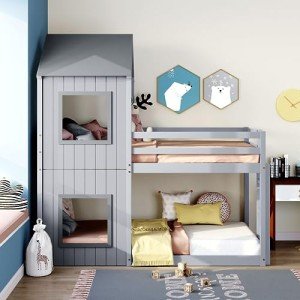The Ultimate Guide to Bunk Beds for Children: Safety, Styles, and Benefits
When it concerns styling a kid's room, parents often face the dual difficulty of making the most of space while guaranteeing convenience and performance. Bunk beds have become a popular service that attends to these requirements, offering not simply sleeping arrangements however likewise contributing to a room's visual. In this detailed guide, we will look into different elements of children's bunk beds, concentrating on their advantages, security features, designs, and considerations for moms and dads pondering this purchase.
Tabulation
- Advantages of Bunk Beds
- Safety Features to Consider
- Types of Bunk Beds
- Design and Style Options
- Upkeep Tips
- Regularly Asked Questions (FAQs)
1. Advantages of Bunk Beds
Bunk beds use various advantages for kids and their parents. Here are some key benefits:
- Space-Efficiency: Bunk beds are an exceptional solution for smaller spaces. By stacking one bed on top of another, more flooring space is readily available for play, storage, or study locations.
- Affordable: When kids share rooms, bunk beds can minimize the requirement for purchasing 2 separate beds, therefore saving money.
- Cultivates Social Interaction: Bunk beds can help brother or sisters or friends bond by sharing a space, creating opportunities for social development.
- Fun Factor: The concept of sleeping "up high" includes a spirited aspect to bedtime, making the shift to sleeping alone much easier for some kids.
- Versatile Design: Bunk beds come in different styles, colors, and designs to match any space style, enabling modification that shows the child's character.
2. Safety Features to Consider
Safety is paramount when it pertains to children's furnishings, specifically when it comes to bunk beds. Here are some important safety functions to examine:
| Safety Feature | Description |
|---|---|
| Sturdy Construction | Frames made of strong wood or metal are preferred. |
| Guardrails | Must be at least 5 inches high and extend along both sides of the upper bunk. |
| Ladder Design | Guarantee ladders are safely attached and have non-slip actions. |
| Bed mattress Size & & Fit | Should fit snugly within the frame to avoid gaps. |
| Weight Limit | Constantly abide by the manufacturer's weight limitation suggestions. |
3. Types of Bunk Beds
Bunk beds are available in numerous designs, accommodating various needs, preferences, and space sizes. Here are some typical types:
- Standard Bunk Bed: The many standard type, with one bed on top of another.
- Loft Bed: Features a high upper bed with space underneath for a desk or play location.
- Futon Bunk Bed: Combines a top bunk with a futon on the bottom, providing versatility for seating and sleeping.
- L-Shaped Bunk Bed: This design has the leading bunk set at a perpendicular angle to the bottom, creating a little corner area.
- Triple Bunk Bed: Accommodates three children utilizing stacked beds, ideal for large families or slumber parties.
4. Style and Style Options
When it pertains to selecting a design for kids's bunk beds, the options are virtually endless. Here are some popular designs:
- Traditional Style: Often made of wood, these bunk beds include ornate information and are ideal for timeless or rustic-themed rooms.
- Modern Style: Characterized by clean lines and minimalist styles, modern-day bunk beds can be made from metal or wood.
- Themed Bunk Beds: Some brand names use bunk beds formed like castles, cars and trucks, or play houses, making bedtime less of a task.
- Convertible Bunk Beds: These can be separated into two individual beds, using flexibility as children grow.
- Colorful Options: Bunk beds in vibrant colors can include a sense of delight and playfulness to any space.
5. Maintenance Tips
Preserving a bunk bed is crucial for durability and security. Here are some pointers:
- Regular Inspections: Check for loose screws or bolts every couple of months and tighten them as needed.
- Cleaning up: Wipe down frames regularly to prevent dust accumulation; think about using a vacuum for hard-to-reach locations.
- Mattress Care: Rotate bed mattress routinely and use protective covers to lengthen their life.
- Look for Wear and Tear: Look for any indications of damage in the wood or metal and think about changing parts if necessary.
- Teach Kids Safety Rules: Encourage kids to use ladders appropriately and guarantee they understand the security features of their bed.
6. Often Asked Questions (FAQs)
Q1: What age is appropriate for sleeping in a top bunk?
A1: Typically, children aged 6 and older are recommended for upper bunk sleeping, as they have the needed motor abilities to climb securely.
Q2: Do bunk beds come with a mattress?
A2: Most bunk beds are sold as frames just, so you will need to purchase mattresses independently. Make sure that the mattress fits the frame comfortably.
Q3: Can bunk beds be separated later on?
A3: Many styles permit conversion into 2 individual beds, providing flexibility for future needs.
Q4: How can I ensure my child's security on a bunk bed?
A4: Comply with security requirements and ensure guardrails, a sturdy frame, and a protected ladder are in location.
Q5: Are there weight limits on bunk beds?
A5: Yes, constantly check the producer's requirements concerning weight limits to make sure security.
Bunk beds for children can serve multiple purposes while guaranteeing security and design. With diverse styles and models readily available on the marketplace, moms and dads can find a system that not just takes full advantage of bed room space however likewise reflects their kid's distinct tastes. As with www.bunkbedsstore.top , understanding security features, maintenance, and how they suit a kid's way of life will make sure that these beds stay a practical furnishings solution for years to come.
Through cautious consideration and adherence to security standards, bunk beds can supply a long-lasting, fun, and practical sleeping service that kids like.

